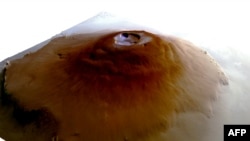Water frost atop volcanoes on Mars has been detected for the first time.
News of the water formations, scientists said, could play a role in human exploration of the Red Planet.
The journal Nature Geoscience published the Mars frost discovery study Monday. Pictures of the frost were taken by the European Space Agency’s Trace Gas Orbiter.
The extinct volcanoes with the frost are on the Tharsis plateau, an elevated region nearly 5,000 kilometers wide near Mars’ equator.
“We thought it was impossible for frost to form around Mars’s equator, as the mix of sunshine and thin atmosphere keeps temperatures relatively high at both surface and mountaintop — unlike what we see on Earth, where you might expect to see frosty peaks,” said lead author Adomas Valantinas, who made the discovery as a doctoral student at the University of Bern in Switzerland. He is currently a postdoctoral researcher at Brown University in the United States.
Olympus Mons, one of the volcanos where the frost was found, is the largest in the solar system, scientists say, and stands almost three times taller than Mount Everest, Earth’s highest peak.
"We saw a shiny, blue deposit there, a particular texture that we only see in the early morning and during the cold seasons," Frederic Schmidt of France's Paris-Saclay University told Agence France-Presse about the frost discovery.
Scientists say the ice covering the water is the thickness of a hair, but what lies beneath is massive.
The ESA said the amount of water lying beneath the daily thin frost of the volcano summits is enough to fill 60 Olympic swimming pools.
Determining how the frost forms, the ESA said, “could allow scientists to reveal more of Mars’ remaining secrets, including where water exists and how it moves between reservoirs.”
“Finding water on the surface of Mars is always exciting, both for scientific interest and for its implications for human and robotic exploration,” said Colin Wilson, an ESA scientist. “Even so, this discovery is particularly fascinating. Mars’ low atmospheric pressure creates an unfamiliar situation where the planet's mountaintops aren’t usually colder than its plains — but it seems that moist air blowing up mountain slopes can still condense into frost, a decidedly Earthlike phenomenon.”













